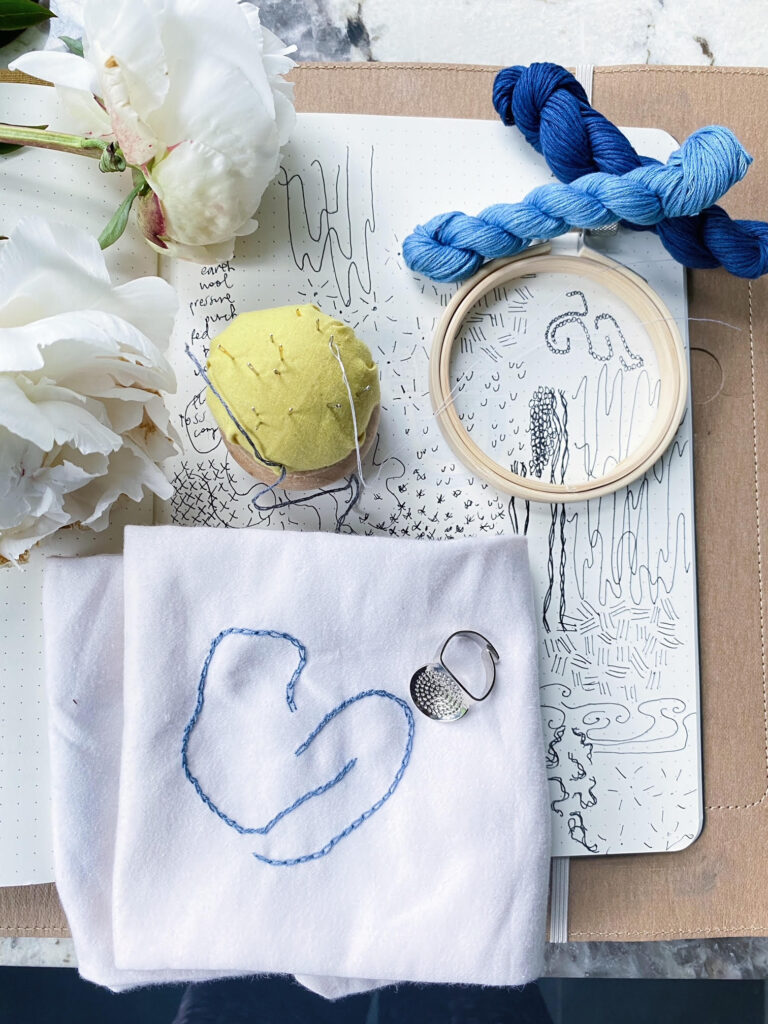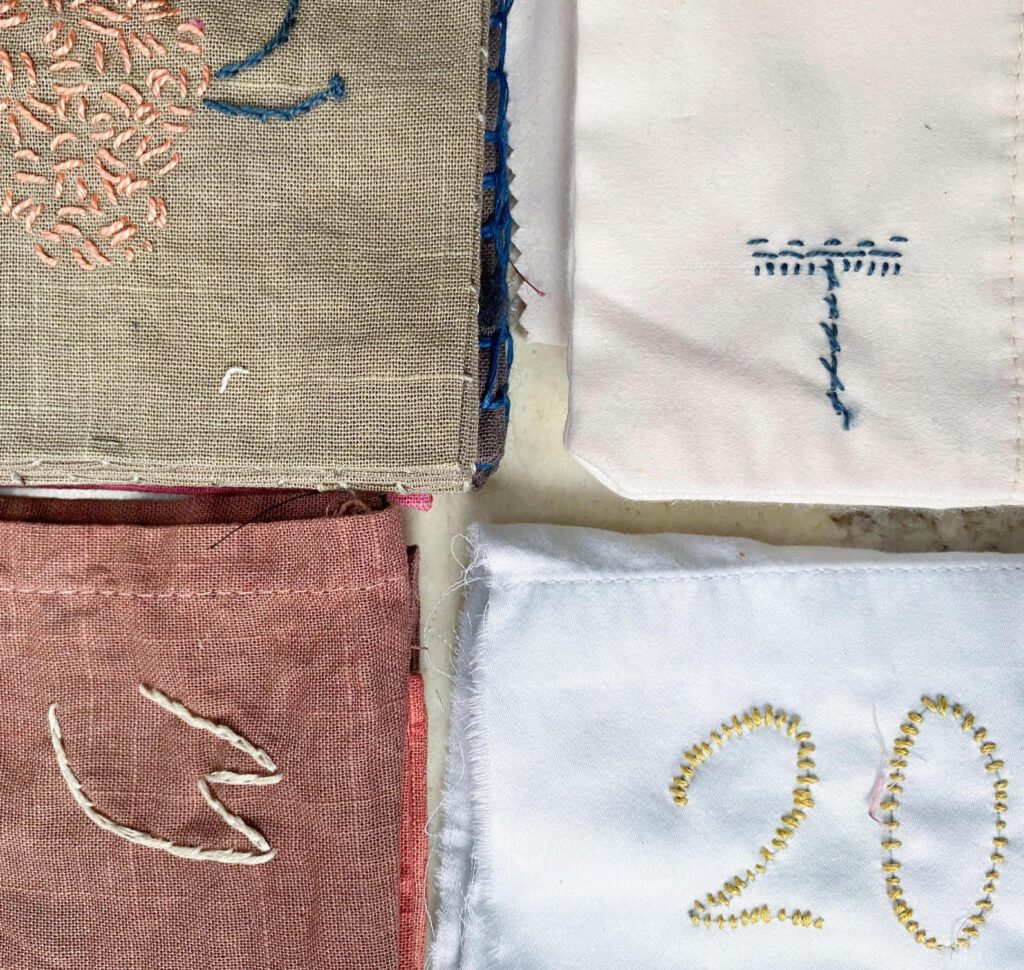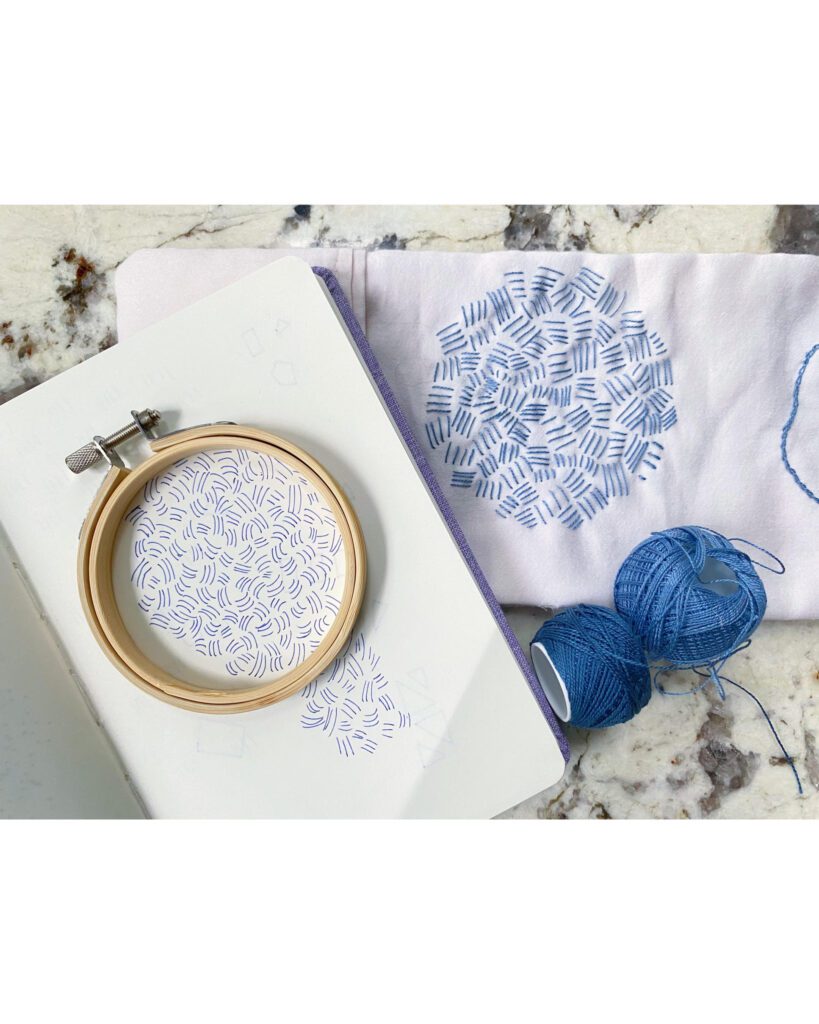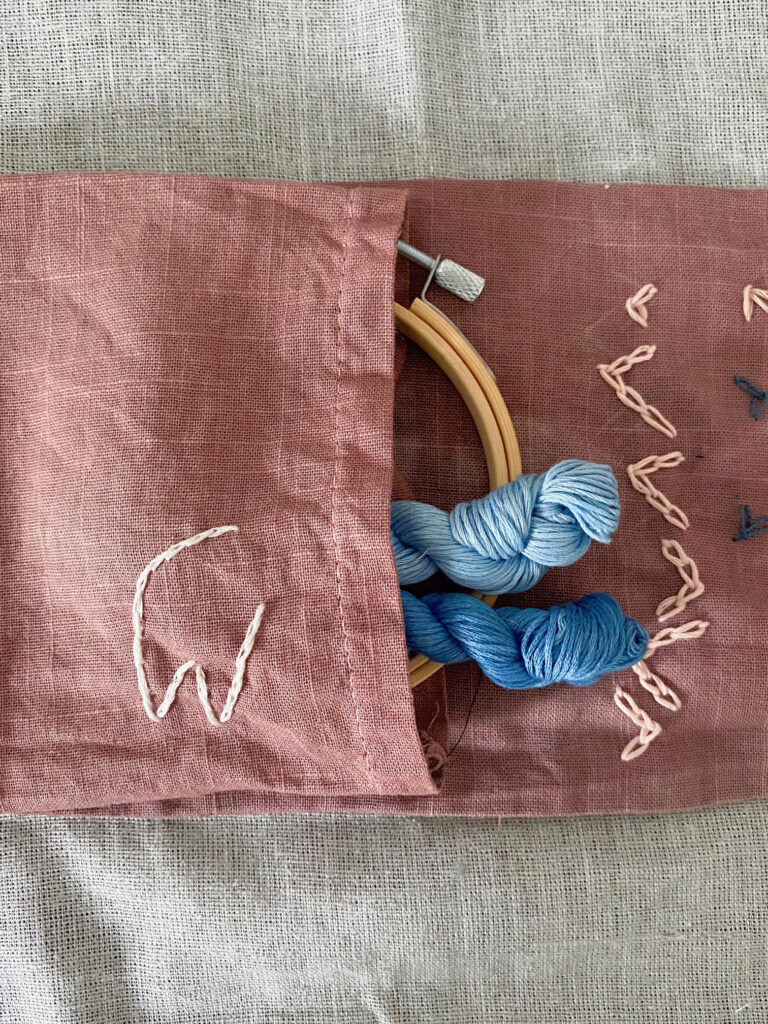
“Our bodies are the conduit through which we experience the world, and contribute to it. As makers, the objects we craft bear the literal mark of our bodies: the imperfections that no machine can replicate, the particular rhythm of our movements, the tension we transfer from our hands to cloth and thread.” — Tamanna Rahman
Mental health clinician and textile artist Tamanna Rahman has a passion for exploring the intersections of craft practice and mental health. She will be joining us as part of the Creative Embroidery series at TATTER to teach Embroidery as Narrative, an in-person workshop on November 16th where students will play with these ideas and learn ways to translate physical experiences of the world to mark-making and stitch. During the class, students will receive a simple cloth embroidery journal to stitch on. Instead of writing out thoughts and feelings, Tamanna will guide students towards representing them in the form of abstract stitches. By the end of the class, they will have begun creating a visual vocabulary that can be honed over time and learned all the embroidery basics needed to continue adding to their journal. In advance of her class, we sat down with Tamanna to discuss the ways in which textiles provide a medium for exploring memory and expression. You can read our conversation and sign up for her class below.
How did you come to your practice as an artist?
It’s only recently that I’ve started to see myself as an artist, but I want to own it. I feel very silly every time that I say it, and I’ve only started saying it within the last year mainly because of Beth Pickens and her book “Make Your Art No Matter What.” She’s a therapist who specifically works with artists and creatives, and she has this really cool online group called Homework Club where people get prompts every month to spur their work and meet together and structure their creative work. There’s a whole part in the book where she says “You are an artist, so you can call yourself an artist.” It’s all about the million reasons we put out there to not make art or not to call ourselves artists or to denigrate our work under capitalism. To think it’s not as valuable as work that generates income. I love this book. I recommend it to so many of my therapy clients who are creatives, too. She is not an artist herself, but she’s helping people who are creative and telling them how they bring so much to our world and enrich her life in so many ways. It’s her life’s purpose as a therapist to support this collective creative process. In my own work as a mental health clinician, it’s definitely become a niche for me that a lot of creatives and artists have ended up in my practice. I learn a lot from them, and I feel like it’s very important to me to support them as well.
How did you start embroidering and what do you bring to teaching from your own learning process?
I started during the pandemic, but I think it was just in my blood. I’ve had so many different creative practices over the years, but as soon as I started doing handwork with a needle and thread it just felt like home. This class is actually a snippet of the larger class I’ve taught of processing experience through narrative embroidery. The focus is how we translate our internal experiences into abstract stitching or mark making. We start with drawing, because drawing is a lot faster than stitching and it allows for the brain dump of playing with all these different marks and then picking pieces that you actually want to transfer to a piece of cloth. What we’re really going to focus on for this workshop is the body. How we take our physical sensations – sight, sound, touch, smell, taste – and make that into some kind of visual mark, shape, or form and then edit that down to something that actually has meaning for us. It’s abstract so we can play with different exercises and creative prompts. It actually feels very intuitive once you start.


You’re the only one in the Creative Embroidery Series who’s creating a usable object, with the journal cover sampler. I love that because I think something that often holds me back from embroidery projects that are creative and abstract is that I’ll start worrying where I’ll put it, how I’ll use it. Am I going to put this on my wall? Am I going to put it away in a drawer? The idea of having it on my wall is just so high stakes. My favorite things to embroider on are always objects, like garments or bags. It feels very stressful to embroider just to embroider. Many of our creative embroidery classes are trying to challenge that and trying to give people the freedom to embroider just to embroider. But I think part of giving that freedom is also removing those barriers to entry like the stress of worrying about usefulness.
I took Maria José Duran’s fabric book class at TATTER, and then I saw she also does that roll up book. That’s just like my book, and I just love her. I feel like we’re kindred spirits. You can keep adding to it forever and make it an eternal book, you can hang it on your wall, you can fold it up in a drawer. You can do whatever you want with it because it’s so low stakes because it’s not finished. You can finish it if you want— I have finished ones— but it’s fundamentally just strips of cloth. It’s fraying at the edges. It’s just meant to be a journal that you can use to document your life. I’ll bring some of my actual journals to class, too, because I’ve been keeping journals forever. They’re filled with things glued in, drawn in, a mess of all the creative process. That’s what these journals are supposed to be. They’re not supposed to be high stakes. Each little section that we do is a maximum of four inches in diameter because of the size of the hoop. If you don’t like it, fold it over and go to the next part.
There is something very low stakes as well about embroidery as a medium, because unless you’re working with a very specific type of cloth or a very specific type of thread, it’s very easy to just pick something out and start over again. I think that’s one of my favorite things about textile arts, the ability to pull everything out and start over again.
Exactly. I was actually just doodling this morning with some of my TATTER natural threads and I just kept pulling it out. This is my third try, and I have just been reworking it again and again. Embroidery thread is so inexpensive and you can embroider on anything. This is on an old pillowcase. So many other fiber arts are so expensive, and there’s such a high barrier to entry. But I can teach anyone to thread a needle and start stitching in five minutes.
Part of what’s so evocative for people as soon as they start working with textiles is that we all have some material memory that just immediately comes up in connection to the cloth. That’s why I love this body focus so much, because it’s so visceral to people to remember the feel of a loved garment. For me, it’s that my mom always had an entire closet of saris in whatever apartment we lived in at the time. I lived in like twelve different apartments growing up, and she maintained an entire closet with hanging saris. I would love going into it. It was like a little jungle and she knew the story of every single one. She would say, “Don’t rub on that one, that’s pure silk … This is Jamdani muslin … This is handwoven.” It was really important for me to learn what kind of fabric each one was and the weave and what made it valuable. It’s so different from how we think about garments now. She still won’t give me any, even though she can’t wear them anymore. She’s afraid I’m gonna cut into them. And I’m like, there’s six yards of fabric here.
I see where her fear comes from.
She did give me a couple, and I realized that they are already finished garments. They’re not ones that I know how to or would wear, but just preserving them as they are feels important. I originally took them because I wanted to make a dress or something. Like, where do you get six yards of vintage Jamdani and cloth from the fifties, and I can’t cut it? 18 feet of cloth worn on your body? It’s crazy. I’ve only worn a sari a handful of times in my whole life, and I definitely can’t put it on by myself. I wish I could. And I think if I was going to do it, I would go rogue and wear like three yards or something cut down.

I think the pleating is the part that I love the most about a sari. I have a friend from Nepal, and his mom gave me a sari as a gift, and the most fun part of it was my friend showing me how to put it on.
There’s hundreds of different ways to do the pleats. I remember that was a huge thing, my dad would be kneeling on the ground helping my mom put on her sari. It’s a two person job. They would do the pleats together, and then if my mom didn’t like it they would do it again. I was always so in awe of how they would do all the pleats and then she would just throw it over her shoulder. I was like, didn’t you just undo them? Usually there’s four sections to this workshop, and one of them is history and memory. We reflect on those textile memories that kind of have the most emotional resonance for us, and for this class I ask people to use old cloth. I’m just going to bring a stack of sheets, pillowcases, whatever people want to use. One, because it’s really environmentally destructive to constantly use new fabric, to contribute to the amount of textile waste in the world for our purposes. But also, I always start with this reading from Claire Hunter’s book, Threads of Life. It’s all about material memory and what’s held in that cloth already. I always think about that because I inherited all these pillowcases from my mother-in-law. After she died, her partner Sylvia gave us all these bed sheets, and they had like 59 pillowcases. I’ve been using them for years now. It’s actually been exactly 10 years since she passed away. I always think about the creases and folds and worn places in those pillowcases as literally the marks of their bodies, the way that they slept. These are very intimate things and that energy enters the work too.

What do you hope that students take from your class?
I think what has been most gratifying to me from past workshops with students is that they’ve felt at ease with embroidering. Many of them who have always worked with patterns thought of embroidery as this fixed thing, and then they realize they can just grab a needle and just start doodling and doing random things, or do a tiny project and not a massive finished piece. There’s so many different ways to employ that form. The second thing is that a lot of people come away with this different connection to their innate sense of creativity. And they’re just like, “I never knew that I could draw like this or create something that looked like this.” You are given the tools to free yourself from the idea of what something is supposed to look like, or a pattern where your end result is never going to look as good as the artist who designed that pattern because they’re working in a specific way and have done that type of work a million times. It’s really gratifying to me when a student goes to the class and they’re like, “Whoa, I can just harness my own creativity and do something completely original.” It’s so low stakes so it takes away that barrier. That’s what I really love about it.
